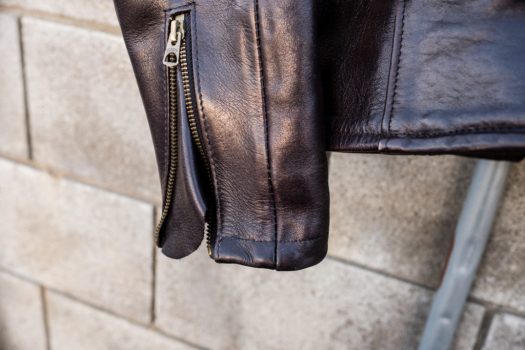(Update 9/25/25) – I have been wearing the jacket at home to break it in. The jacket’s arm creases have settled, and leather softened, and now it sits closer to my body than brand new.
In this set of pictures below wearing the Schott 618 Perfecto with mid-high rise pants and my shirt tucked. You can see the fit on me is boxy, cropped, and the jacket length places the buckle near my pants belt line.
Here below, I am wearing the 3sixteen x Schott Arabica Perfecto which is based on the 519 cut. It has a slim fit to the body and arms (do note it is a size Medium compared to the 618 in size 44 which corresponds closer to a Large) and I don’t have much room to layer. The body length is extended.
My recent jacket purchase is is the Schott 618HH aka the Classic Perfecto in Horsehide leather. I recently visited the Schott Los Angeles Flagship Store in the Fairfax neighborhood. The last time I was there was nearly 8 years ago when I was very ecstatic to locate a 3sixteen x Schott Arabica Cowhide Perfecto in my size the day after it had been released. The store had then recently moved locations from the Americana in Glendale to the the Fairfax area in Los Angeles.
I am 5’10 with a 41 inch chest and about 165 lbs. I used the Schott NYC website size calculator to input my measurements. It suggested size 42 for a “slim fit” and size 44 for a “regular fit”. When I was trying on the 618HH jacket, the size 42 felt very tight in the chest and shoulders and was pulling much in the chest. The size 44 fit better in those areas, although boxier in the body. The store associates suggested that either size could work. Factors to consider are if you would like to layer underneath, to wear it on a motorcycle, to leave space for weight fluctuation, or to wear for fashion only. After significant consideration, I decided to go with the larger size 44.
My initial impressions of the jacket is that the horsehide leather is very stiff, shiny, and has lots of grain. Some of the panels have more grain such as the collar on my jacket. I currently have a Schott 519 jacket which I can compare to in materials and style.
The Schott 519 is a medium weight, soft waxy pebbled cowhide leather with a longer body length for fashion, open sleeve cuffs, and ‘One Star’ on the rounded epaulets. The leather is soft and comfortable to wear brand new, yet the cowhide is quite resistant to scuffs. My size M jacket weighs 4.62 lbs. The pit to pit measures 22 inches. The front length is 27 inches, and the back length is 25 inches. The 519 includes a belt snap to prevent the buckle from flopping around when unbuckled. It has a 3oz poly quilt liner.
The Schott 618HH is a heavy weight, rigid horsehide leather, with a shorter classic body length, underarm footballs, and zippered sleeve cuffs. The brand new jacket feels like wearing a shiny cardboard. The shiny look might be off putting to some as it looks like vinyl or fake leather. A size 44 jacket weighs 5.46 lbs. The included underarm football gussets make the arm movements reaching in front and across the body feel very natural and comfortable. It feels like a practical addition, and the gussets visually don’t add too much bulk if you have some upper arm muscle. The front length measures 25.5 inches, and the back length is 25 inches. I noticed the set of zippered handwarmer pockets and zippered chest pocket directions are opposite of the Schott 519 – they are closed in the downward position and open upwards, while on the 519 it is the other way around. The poly quilt liner is a bit thicker at 5.5oz and warmer.























































































































































































































































